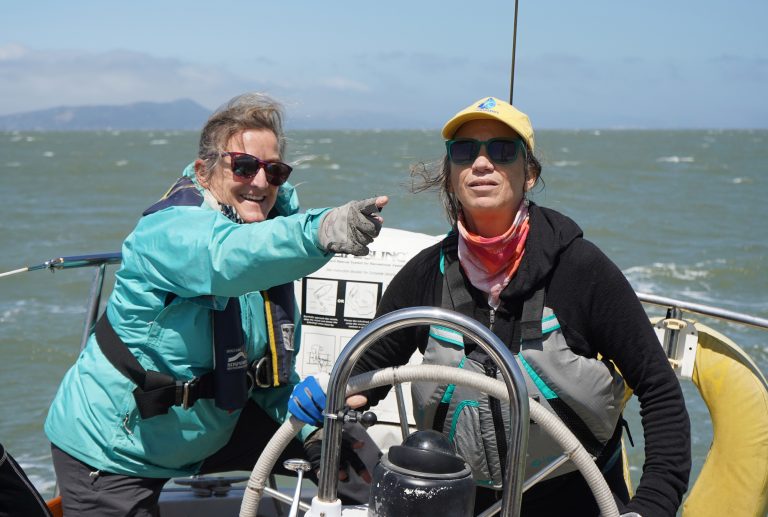
Lauren Eisele: Up to Her Neck in Sea Level Rise and Sailing
The good news about sea level rise is we might not have to do so much dredging. The bad news is the pedestrian bridge over the Estuary will have lower clearance, while other aspects of boating access may get curtailed as marinas, yacht clubs and other facilities become undermined, flooded, eroded or inaccessible. As always, the future is a mystery, but folks like Lauren Eisele and others in charge of looking ahead are taking action today.

We received a note from Bay Area sailor Lauren Eisele, who’s one of many people and organizations planning for and helping to mitigate these climate impacts. She sent us a note keeping us updated with her latest mission to help the Bay Area create climate change resiliency. Coastal communities worldwide are at varying stages of trying to both prevent sea level rise and adapt to however much is coming our way. Eisele credits Bay Area municipalities for being ahead of the curve compared to many coastal regions.
Lauren has had many sailing adventures and much instructional time at Club Nautique. She’s also been running women’s sailing seminars such as the one at the Corinthian Yacht Club this past fall, and she conducts many other instructional and charter operations on the water. Her professional career includes roles as Senior Maritime Project Administrator for the Port of Oakland and Senior Environmental Planner for the Port of San Francisco. This is just the tip of the melting iceberg. (The world’s largest iceberg just broke off in Antartica.)

Lauren wrote, “As a member of my Bay Area community, I know you are concerned with the potential effects of climate change on our communities. Where and how we live, work and play will all be impacted in the near future. But the good news is that our local governments, academic institutions and community-based organizations are informed, and are initiating many efforts to address the potential impacts of flooding, extreme heat, drought, wildfire and the resultant public health impacts. We are very lucky to have these educated, concerned and capable people working on our solutions, but we need more engagement from the private sector and residents like you.”
For those interested in learning more and helping, Lauren sent a few links to programs currently underway, as well as the video below from the BCDC.

While we applaud the BCDC’s initiatives to preserve and protect the waterfront, we’re disappointed when the soundtrack suggests a focus on bike and pedestrian pathways, which we feel is a misguided view of preserving “Bay access.” Our interpretation of Bay access is all paths that lead into and out of the Bay (launch ramps, marinas, youth programs, etc.), not just the paths behind the riprap shorelines that ring the Bay. The December story from Max Ebb highlights some of the failures of Bay access for small boats with a story on “Roll Your Own Water Trail.”

Lauren is working with local Alameda and Oakland communities on groundbreaking adaptation planning studies for the Oakland-Alameda Estuary and San Leandro Bay, and sent some links for those who’d like to see what these projects might entail. Like the pedestrian bridge over the Estuary or the proposed rebuilding of the San Francisco Marina, many projects reach the boating community last. It’s wise for those with waterfront interests to be aware of what’s happening and have their voices heard earlier rather than later.

The Oakland-Alameda Adaptation Working Group is leading three adaptation projects:
Subregional Long-Term Adaptation Plan
Oakland-Alameda Estuary Adaptation Project
Bay Farm Island Adaptation Project
As Lauren wrote, “Our leaders can’t solve these problems in a vacuum; they need your help. Please consider participating in these projects and helping spread the word.” So we’re spreading the word.
As we move into the new year, Lauren will be up to her neck in teaching more sailing and leading more focused community engagement on local sea level rise resiliency so we can all keep our heads above water. Specifically, she’ll be working on the Oakland-Alameda Estuary Adaptation Project, which will include waterfront walks and talks in spring 2024. Sea level rise is a slow process, but so is the permitting and civil and human engineering needed to address it. With everyone’s participation, the health of the Bay and waterfront access can be maintained.
If you would like to join Lauren and other forward-thinking people to help the Alameda Area adapt to rising sea levels, you can contact Gail Payne at the City of Alameda.
